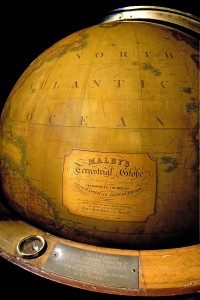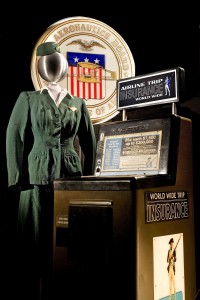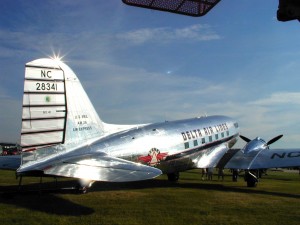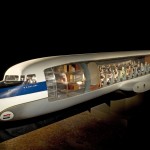
Juan T. Trippe, Pan American Airways founder and president, used this 19th-century globe in his New York office to plan routes around the world. Pan American Airways’ publicity prominently featured the globe.
By Henry M. Holden
Washington D.C.’s Smithsonian National Air and Space Museum will open its newest permanent exhibition, “America by Air,” on Nov. 17. Using a collection of artifacts, photographs, artwork and interactive media, the gallery will display the history of passenger air travel in the United States. From the early attempts to form airlines only a decade after the Wright brothers’ first flight, to the commercial challenges and technical sophistication of the 21st century jet age, the exhibit will whisk the viewer back in time to when air travel went from dangerous to glamorous.
With the advent of airmail and Charles Lindbergh’s solo transatlantic flight in 1927, Americans were encouraged to travel by air. The exhibition will show how paying passengers got off the ground: first in fragile and unsafe aircraft, to the experience of a luxurious adventure, and then to a tedious necessity.
In the mid-1920s, Henry Ford created the first commercial airline with his Ford Tri-motor. With the help of a specially built platform installed in the museum’s gallery, visitors looking up at the suspended 5-AT Tri-Motor will be able to feel and hear the throbbing vibrations that rattled travelers aboard the Tin Goose. While Ford built 199 Tri-Motors, by later standards, the corrugated metal airplane was unsafe and uncomfortable. Those were the primary reasons William Boeing created his Boeing 247; Donald Douglas followed shortly afterwards with the airplane that changed the world, the Douglas DC-3.
“Passenger air travel is so ingrained in our culture, it’s natural that we take its development and success for granted,” said Gen. J.R. “Jack” Dailey, the museum’s director. “‘America by Air’ reminds us how no other machine but the airliner put the far corners of the world within reach for so many. It’s impossible to imagine modern life without it, and it’s hard not to relate instantly to this new gallery.”
The exhibition is divided into four thematic sections: Early Years, 1914-1927; Expansion and Innovation, 1927-1941; Piston-Engine Era, 1941-1958; and Jet Age, 1958-Today.

The America by Air exhibition will feature a sweeping array of artifacts to tell the story of passenger air travel in the United States. Passengers could buy $7,500 worth of life insurance from a vending machine for 25 cents.
America by Air also recalls the federal government’s role in commercial air travel development. By turning airmail service over to private industry, which encouraged the growth of airlines, the government soon realized it needed a coherent air traffic control system. It introduced early regulations aimed at encouraging growth and created valuable technologies through the National Advisory Committee for Aeronautics, the predecessor to NASA. A large NACA sign on display comes from one of the landmark wind tunnels in Langley, Va., which helped produce breakthroughs in aircraft design in the 1920s and 1930s.
Interactive displays
As part of the gallery experience, visitors will be able to cross a 30-foot-high pedestrian bridge and step inside the forward fuselage of a retired Boeing 747, donated by Northwest Airlines. Visitors will get a close-up look at the cockpit along with the view from the upper deck of the wide-body airliner that became an icon of the “jet set” era.
A life-size interactive cockpit simulation of an Airbus A320 taking off and landing at Ronald Reagan Washington National Airport is also featured. The graphics, seen through the windshield, show the nation’s capital and its landmarks in remarkable detail.
Other airplanes representing the formative years of air transportation are a Ford Tri-Motor, Curtiss JN-4D Jenny, Pitcairn PA-5 Mailwing, Fairchild FC-2, Northrop Alpha, Boeing 247-D and Douglas DC-3. A DC-7 forward fuselage and interior will be open to the public.
While most of the aircraft suspend from ceiling trusses, the Jenny is much closer to eye level on supports just outside an improvised airmail hut. Surplus Jennies from World War I became the first aircraft used in regular service by the U.S. Post Office. The museum’s JN-4D, in pristine, unrestored condition, was last displayed by the Smithsonian during the 1960s.
While the airframes grew larger and more comfortable, advances in engine technology allowed the airlines to lift greater loads of passengers and cargo and transport them farther and faster. Several key passenger airplane engines from the 1920s to the 1970s will be displayed in the gallery, including the trailblazing 1926 Wright Whirlwind, and a Rolls-Royce RB211 high-bypass turbofan.

Henry Ford’s Tri-Motor was a dangerous machine. Its pilots breathed fumes from the nose engine, and constant tooth-rattling vibrations from the engines carried throughout the airframe.
Among the many interactive features, animated maps on large, high-definition screens will present a compressed day in the life of today’s complex airline routes and how bad weather affects them. The same displays will show visitors how air traffic controllers cleared the skies over the U.S. on Sept. 11, 2001, in just a few unprecedented hours.
Visitors will be able to compare models of piston and jet engines and test the differences between control systems, from simple stick-and-wires to hydraulics and NASA-developed computer-based, fly-by-wire technology.
The exhibition will highlight some of the people who turned air travel into an industry and a culture. Visitors will learn of the lesser-known work of Charles Lindbergh, who helped chart some of the nation’s initial airline routes. The gallery also features pioneers like Ellen Church, who suggested putting nurses like her in the sky as the first stewardesses, and pilot Marlon Green, who broke the major airlines’ whites-only barrier in 1965, with a discrimination suit against Continental Airlines.
Highlights from the museum’s extensive air travel poster collection will illustrate how airline advertisements initially focused on issues of safety and comfort. As passengers grew increasingly savvy, they gradually shifted their focus to destinations.
Modern aviation

The DC-3 first flew in 1935 and became the standard for air travel until the 1950s. Some were still in passenger service through 1985. The aircraft held up to 28 passengers and had many safety features.
With a variety of evocative displays, the exhibition puts into context the modern airliner’s crucial role in swiftly moving time-sensitive cargo such as transplant organs, produce and seafood. The Washington Nationals baseball team has donated bats, a helmet, a team jacket and an equipment travel bag to represent how modern aircraft dramatically streamlined the road trip and expanded the reach of professional sports.
Special photo opportunities for visitors will be available throughout the gallery, including cutouts of soot-covered airmail pilots and traveling stars from Hollywood’s golden era. An airline chewing-gum dispenser, complimentary flight bags, a travel insurance vending machine and provocative stewardess uniforms from the 1960s and the hot pants of the 1970s also help tell the exhibition’s story.
To explain the economics of the post-deregulation era, an interactive price “meter” will challenge visitors to spend $300 or less on a plane ticket while deciding whether they can do without such comforts as a nonstop flight, sufficient legroom and food service. An “In the News” section in the gallery and on the exhibition website will provide information on the latest innovations and events in air travel.
Opening day has been designated Family Day and will include curator presentations and story times for young visitors.
For more information, visit [http://www.nasm.si.edu].
- Airlines used large models in mid-20th century advertising to show comfortable cabin seating for travelers.
- Although the Boeing 247 carried only 10 passengers, it was a giant step forward in passenger comfort and safety. It had steam heat, deicers and a nurse/stewardess who served hot meals.













